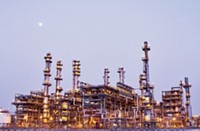Advertisement
Grab your lab coat. Let's get started
Welcome!
Welcome!
Create an account below to get 6 C&EN articles per month, receive newsletters and more - all free.
It seems this is your first time logging in online. Please enter the following information to continue.
As an ACS member you automatically get access to this site. All we need is few more details to create your reading experience.
Not you? Sign in with a different account.
Not you? Sign in with a different account.
ERROR 1
ERROR 1
ERROR 2
ERROR 2
ERROR 2
ERROR 2
ERROR 2
Password and Confirm password must match.
If you have an ACS member number, please enter it here so we can link this account to your membership. (optional)
ERROR 2
ACS values your privacy. By submitting your information, you are gaining access to C&EN and subscribing to our weekly newsletter. We use the information you provide to make your reading experience better, and we will never sell your data to third party members.
Business
Refining Chemicals
Petrochemical makers are looking beyond the ethylene steam cracker as a source of olefins
by Alexander H. Tullo
April 23, 2007
| A version of this story appeared in
Volume 85, Issue 17

FACED WITH tough competition, petrochemical companies are searching for any advantage they can get. Increasingly, they are finding their basic chemicals in a place they normally go to for raw materials: the oil refinery.
Helping these companies are advances in fluid catalytic crackers, or FCCs, which are components of most refineries. Although primarily used to make gasoline, FCCs produce nearly one-third of the world's propylene. With propylene prices rising, technologies that increase FCC output of propylene and other chemicals are piquing the interest of chemical makers.
At Chemical Market Associates Inc.'s (CMAI) World Petrochemical Conference last month, Colin P. Bowen, vice president of olefins business development at Shaw Stone & Webster (SSW), explained the reasons for propylene's increasing value.
About two-thirds of the world's propylene is made as a coproduct in ethylene steam crackers. However, the global propylene market is growing at a 4.9% annual clip, while the ethylene growth rate trails at 4.3% per year. Moreover, most of the ethylene capacity being built is based on ethane, a feedstock that yields little propylene. "The relative pricing of propylene and gasoline will provide obvious incentive to several refiners to adjust FCC operation," Bowen reasoned.
James Glavin, product line manager for FCC, alkylation, and treating technologies for the engineering firm UOP, agrees. "There is a developing propylene gap," he says. "And people are discovering that FCCs provide a very flexible means to fill that gap."
In a typical FCC unit, catalysts break down long-chain refinery fractions, such as vacuum gas oil, into useful products, among them gasoline, liquefied petroleum gas (LPG), and propylene. In recent years, chemical engineers have been incorporating zeolite catalysts such as ZSM-5 into FCCs to boost propylene yields to 8% by weight from about 4 wt % traditionally.
But newer processes, known generally as high-olefin catalytic cracking (HOCC), take petrochemical production a step further. Two prominent examples are SSW's Deep Catalytic Cracking (DCC) process and UOP's PetroFCC.
The catalysts used in HOCC processes incorporate much more ZSM-5 than do normal FCC units. HOCC units also operate at a "higher severity" than ordinary FCC units, meaning higher temperatures, catalyst-to-oil ratios, and steam-to-hydrocarbon ratios, Bowen says. He adds that product recovery is different in HOCC because the process yields more gaseous products like propylene and ethylene.
The DCC process was developed in the 1990s by China's Sinopec and its Research Institute of Petroleum Processing. SSW has rights to DCC outside of China.
Bowen says his company offers two versions of DCC. DCC-1 is designed for plants intended to produce high volumes of olefin. The process can yield up to 23 wt % propylene as well as 5-7 wt % ethylene. DCC-2 incorporates less zeolite catalyst and produces 12-14 wt % propylene and 4-6 wt % ethylene.
UOP's PetroFCC technology can put out 22 wt % propylene and 6 wt % ethylene from a typical vacuum gas oil feedstock. UOP could design a plant that puts out even more olefins, Glavin says, but customers usually seek a 10-15 wt % propylene yield.
UOP is installing a PetroFCC unit at Petron's refinery in the Philippines. Scheduled to start up in 2008, the new unit will produce 15 wt % propylene from vacuum gas oil. Twelve plants using the DCC technology are either in operation or under construction, mostly by Sinopec in China.
The most ambitious use of DCC will be the PetroRabigh joint venture in Saudi Arabia between Saudi Aramco and Sumitomo Chemical. The enormous project, estimated to cost more than $9 billion, will include an expansion of an existing refinery, a DCC unit, and an ethane-based ethylene cracker.
The DCC unit, fed with vacuum gas oil produced at the adjacent refinery, will yield about 20 wt % propylene and 4 wt % ethylene, Bowen says. These product streams will be combined with the output from the ethylene cracker to produce 1.5 million metric tons of ethylene and 950,000 metric tons of propylene per year.
Bowen says such an integrated unit unlocks DCC's advantages. For instance, ethane and propane produced in the DCC can be recycled back to the ethylene cracker. Steam generation, propylene fractionation, and contaminant removal can be shared between the DCC unit and ethylene cracker.
Although HOCC technologies are becoming popular, producing more chemicals and less fuels isn't for everyone, says Chuck Carr, director of propylene studies at CMAI. "You are just upgrading what you have as gasoline and turning it into propylene," he points out.
UOP's Glavin acknowledges that the trade-off is like "robbing Peter to pay Paul." Output of gasoline can be reduced from 55 wt % in normal FCC units to 30 wt % in PetroFCC. "You are getting your olefins materials from the gasoline range," he says. Thus, he sees a niche for the HOCC processes in regions such as the Middle East and Asia that are focused on chemicals.
SSW's Bowen says HOCC can be a low-cost way to make chemicals from cheap feedstocks. He explains that vacuum gas oil sells for about 90% of crude oil, whereas naphtha, the traditional ethylene cracker feedstock, sells for 120-130% of crude.
Another HOCC technique, the Catalytic Pyrolysis Process, or CPP, takes even more advantage of the price difference between vacuum gas oil and typical petrochemical feedstocks. Developed by Sinopec and licensed by SSW outside of China, CPP produces olefins by carbenium scission and free radical initiation. Propylene yields can be 18-25 wt %, and ethylene output ranges between 10 and 21 wt %.
The first plant using the technology is being built in China by Shenyang Paraffin Wax Chemical Co. and is scheduled to start up in 2008. An $8.3 billion petrochemical project planned for Rio de Janeiro will use a technology similar to CPP developed by Petrobras, Brazil's state oil company.
To Bowen, such projects are evidence that petrochemical makers are attempting to bridge the gap between chemical production and refining. At the CMAI conference, he called FCC a "key refining technology that can provide petrochemical advantages."
- Refining Chemicals
- Petrochemical makers are looking beyond the ethylene steam cracker as a source of olefins
- Technology
Turning Ethylene Into Propylene





Join the conversation
Contact the reporter
Submit a Letter to the Editor for publication
Engage with us on Twitter